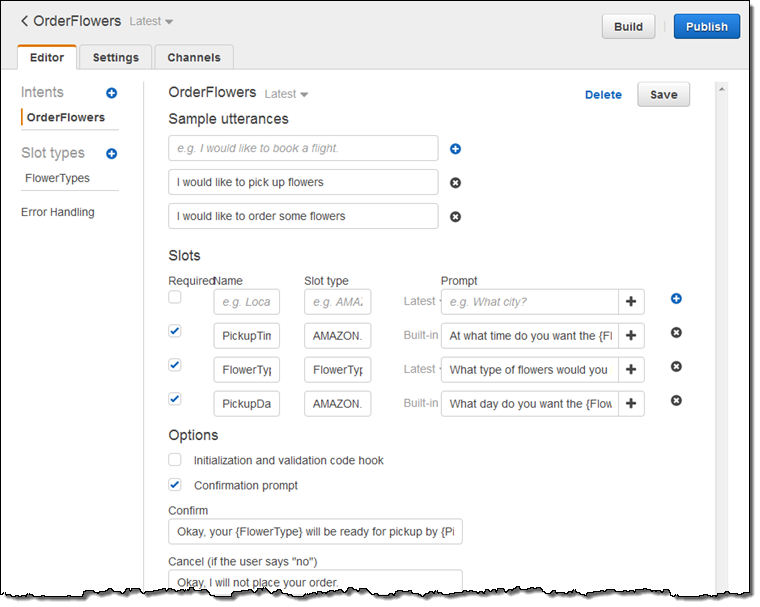


Tier 3 content redaction pricing of 0.00102/minute (58% discount to T1 pricing) applies to the next 4,000,000 minutes. Tier 2 content redaction pricing of $0.0015 (38% discount to T1 pricing) applies to the next 750,000 minutes. Virginia), Tier 1 (T1) content redaction pricing of $0.0024 applies to the first 250,000 minutes of transcriptions.
Amazon lex speech to text api plus#
Virginia) includes the standard transcription cost of $27,450 calculated above plus an additional cost for automatic content redaction. Now let's assume that those 200,000 calls contain personal identifiable information (PII) like Social Security numbers and birth date information that you need to remove. Total cost = + + = $27,450Ĭall transcription with automatic content redaction example Total monthly call minutes transcribed in US East (N. Since your usage volume crosses three different pricing tiers, your monthly charges will be as follows. Tier 3 pricing of $0.0102/minute (58% discount to T1 pricing) applies to the next 4,000,000 minutes. Tier 2 pricing of $0.015/minute (38% discount to T1 pricing) applies to the next 750,000 minutes. Virginia), Tier 1 (T1) pricing of $0.024/minute applies to the first 250,000 minutes of transcriptions. This equals 2 million minutes of audio per month in the US East (N. When using file:// the file contents will need to properly formatted for the configured cli-binary-format.Īutomatically prompt for CLI input parameters.ĭisable automatically prompt for CLI input parameters.Let’s assume that you want to use Amazon Transcribe to process 200,000 live calls per month and the average call is about 10 minutes each.

When providing contents from a file that map to a binary blob fileb:// will always be treated as binary and use the file contents directly regardless of the cli-binary-format setting. The raw-in-base64-out format preserves compatibility with AWS CLI V1 behavior and binary values must be passed literally. The base64 format expects binary blobs to be provided as a base64 encoded string. The formatting style to be used for binary blobs. If the value is set to 0, the socket connect will be blocking and not timeout. The maximum socket connect time in seconds. If the value is set to 0, the socket read will be blocking and not timeout. The CA certificate bundle to use when verifying SSL certificates. Credentials will not be loaded if this argument is provided. Overrides config/env settings.ĭo not sign requests. Use a specific profile from your credential file. This option overrides the default behavior of verifying SSL certificates.Ī JMESPath query to use in filtering the response data. For each SSL connection, the AWS CLI will verify SSL certificates. Override command’s default URL with the given URL.īy default, the AWS CLI uses SSL when communicating with AWS services. If you configure a timeout, the timeout message is returned when the period times out.įor more information, see Completion message. Timeout message - If you don’t configure a timeout message and a timeout, and the Lambda function doesn’t return within 30 seconds, the timeout message is returned.Failed message - The failed message is returned if the Lambda function throws an exception or if the Lambda function returns a failed intent state without a message.Success message - Returned if the Lambda function completes successfully and the intent state is fulfilled or ready fulfillment if the message is present.For more information, see PostFulfillmentStatusSpecification. If the optional post-fulfillment response is specified, the messages are returned as follows. The example contains a Java application that compresses and encodes a Java object to send to Amazon Lex V2, and a second that decodes and decompresses a response from Amazon Lex V2. Before you can use these fields, you must decode and decompress them. The following response fields are compressed using gzip and then base64 encoded by Amazon Lex V2. The following request fields must be compressed with gzip and then base64 encoded before you send them to Amazon Lex V2. Amazon Lex V2 interprets the user input using the machine learning model built for the bot.

Clients use this API to send text and audio requests to Amazon Lex V2 at runtime.


 0 kommentar(er)
0 kommentar(er)
